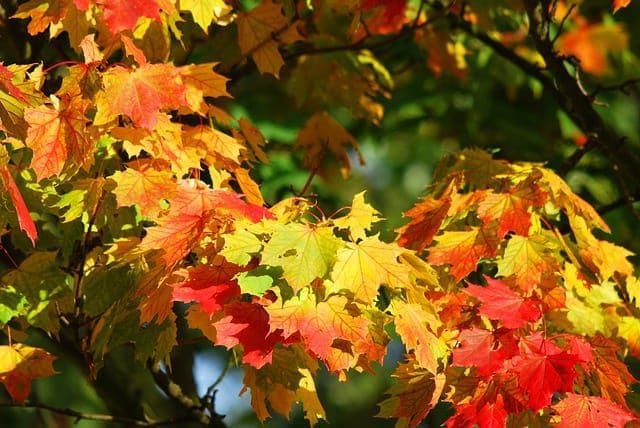As the leaves change color and the air turns crisp, it’s time to shift our focus from summer fun to winter preparation. Just like you might prepare your home for the colder months, your lawn and landscape also require a bit of TLC to ensure it thrives through the winter. To emerge healthy and vibrant in the spring. Here are some essential fall lawn care tips and landscape reminders to help you achieve that lush green lawn next spring.

Fall Garden Essential Tips
- Cut Back Perennial Plants: prepare perennials for winter.
- Divide Perennials: where needed to promote healthy growth and multiplication
- Cold Sensitive Bulbs: Dig up, cover, or mulch to safeguard and insulate through winter
- Spring-Blooming Bulbs: plant during the fall so they will come in well established in spring. See our list of the best Native bulbs to plant during fall
- Mulch: to protect you plant roots during winter
- Don’t Forget: to drain and store garden hoses so they won’t freeze and break

Fall Lawn Care Tips
- Mow: Maintain a healthy lawn height
- Water: if you watered your lawn regularly all summer it’s important to continue so that grass roots keep growing deep
- Soil Test: Assess your lawn’s nutrient needs
- Top-Dress the lawn: to smooth out unlevel spots
- Overseed: for a thicker fuller lawn next year
- Reseed Bare Spots: to take care of those bare spots in the lawn
- Aerate: improving soil aeration will help your lawn get more nutrients and water to the roots
- Fertilize: fall is the perfect time to nourish the lawn with nitrogen
- Mulch Fallen Leaves: turn fallen leaves into nutrients for you lawn
- Gutter Cleaning: to prevent blockages and water damage
- Winterize Irrigation Systems: to prevent leaks and frozen pipes
- Leaf Removal: be sure leaves are not piled by your homes foundation to prevent damage
- Don’t Forget: Winterize and properly store lawn equipment
Why Fall To Do Essentials Matter
Fall presents a golden opportunity for lawn care enthusiasts. The growing seasons ending gives lawn and gardens across Northwest Arkansas a time to rest before spring. Fall is one of the best times to perform a soil test. Testing soil nutrient levels helps determine the right fertilizer for your lawn or garden. The soil test result results set the stage for aeration, topdressing, and overseeding. Timing in lawn care can be everything. Appling a high-nitrogen fertilizer after lawn aeration can nourish your grass throughout the cold winter.
Should The Lawn Be Watered In Fall
Yes, it’s also important to keep watering regularly your lawn in fall if the lawn was watered during the growing season. A lot of times watering gets forgotten as the days get cooler. If rainfall is low during the fall the grass needs to be watered if it was continually watered all summer. Roots grow deeper when grass gets more water. During a drought or when water is suddenly cut out grass root in the lawn shrink and move closer to the surface. Watering the lawn during fall helps keep lawn grass roots deep for the cold days ahead.
Should The Lawn Be Mowed In Fall?
Yes, keep mowing, mulching leaves is even better it turns the fallen leaves into food for the lawn. Fall is also an excellent time to check your mower deck height and move it up a notch. 2 J’s & Sons recommends one notch higher on the mower deck as a good height for grass through the winter. The longer grass blades will help protect the lawns root system from frost and cold in cool climates like Northwest Arkansas. Taller grass in the winter also helps reduce lawn stress for cool season grass types.
| Cold Season Grasses | Fall Cold Season Grass Mow Hight |
|---|---|
| Cold Season Grasses | |
| Fescue | 3 inches |
| Ryegrass | 3 inches |
| Kentucky Bluegrass | 3 inches |
| Warm Season Grasses | |
| Bermuda | 2 inches |
| Zoysia | 2 inches |
| St. Augustine | 2 inches |
Should Fallen Leaves In The Lawn Be Mulched During Fall?
Yes, mulching fallen leaves is an important for maintaining lawn health. Rather than viewing those autumn leaves as a nuisance, consider them a valuable resource for your lawn. When mulched, leaves break down into organic matter, enriching the lawns soil with nutrients. This organic matter acts as a natural fertilizer. Promoting microbial activity and improving soil structure. It also helps the soil retain moisture, reducing the need for additional watering. Mulching fallen leaves prevents the formation of a thick, suffocating layers on the lawn. Heavy wet leaves can impede air and water movement. 2 J’s & Sons recommends mulching fallen leaves as a sustainable and eco-friendly approach to lawn care.
Fall Maintenance Safety Tips
- Chimney Sweep: don’t risk a chimney fire if the power goes out
- Dryer Vent Sweep:
- Smoke Alarm: remember to check the batteries

